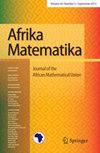A Solow-Swan framework for economic growth with memory effect
IF 0.7
Q2 MATHEMATICS
引用次数: 0
Abstract
The Solow-Swan equation is a cornerstone in the development of modern economic growth theory and continues to attract significant scholarly attention. This study incorporates memory effects into the classical Solow-Swan model by introducing a formulation based on the Caputo fractional derivative. A comparative analysis is conducted between the integer-order and fractional-order versions of the model to examine the influence of fractional dynamics on capital accumulation. The findings reveal that the inclusion of a fractional-order derivative significantly affects the trajectory and long-term stability of capital, offering a more flexible and comprehensive framework for modeling economic growth processes.
具有记忆效应的经济增长的索洛-斯旺框架
索洛-斯旺方程是现代经济增长理论发展的基石,并继续吸引着重要的学术关注。本研究通过引入基于卡普托分数阶导数的公式,将记忆效应纳入经典的索洛-斯旺模型。通过对模型的整数阶和分数阶版本进行比较分析,考察分数阶动态对资本积累的影响。研究结果表明,纳入分数阶导数显著影响资本的轨迹和长期稳定性,为经济增长过程建模提供了一个更灵活、更全面的框架。
本文章由计算机程序翻译,如有差异,请以英文原文为准。
求助全文
约1分钟内获得全文
求助全文

 求助内容:
求助内容: 应助结果提醒方式:
应助结果提醒方式:


